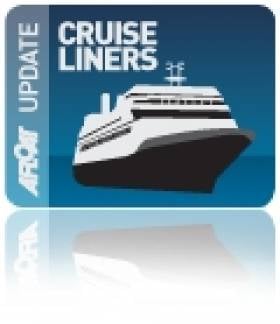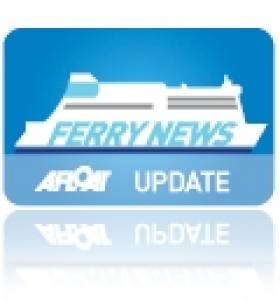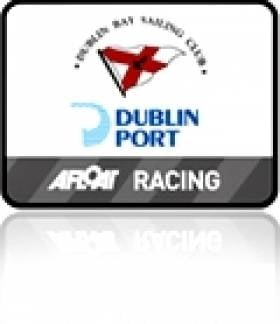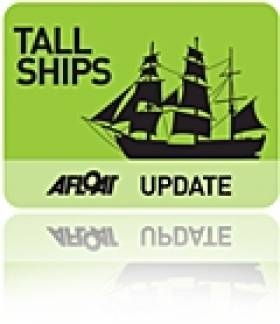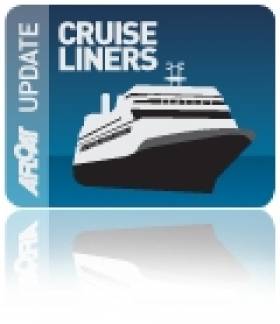Displaying items by tag: Dublin Port
Clipper Cruiseship Calls In for Fish & Chips
According to her schedule the Clipper Odyssey has since made several calls to include Waterford, Cobh and along the stunning scenery of the western seaboard with anchorage calls off the Great Blasket Islands, Dingle.
Yesterday the 5,218 tonnes vessel operated by Clipper Cruiuses had also called to Inishmore of the Aran Islands. Otherwise the 120 passenger cruiseship is normally found serving in the Pacific Ocean from New Zealand to the Russian Far-East. She is due to depart Co. Donegal this evening bound for Portrush.
As for the 226-passenger Le Diamant she is a frequent caller not just to Dublin, she had arrived from Penzance. The 8,282 tonnes vessel is run by Marseilles based Ponant Cruises and the twin-funnelled vessel is due to depart this evening for Fishguard.
First Heysham-Max Newbuild Launched for Seatruck Ferries
The quartet of Heysham-Max class vessels are the largest ever vessels built to operate from the Cumbrian port which has determined the length of the new ships. Despite the restrictions imposed by the dimensions of the port, the optimum cargo-load of the newbuilds were achieved by positioning the deckhouse forward so to guarantee un-hampered loading of the upper decks.
Propulsion is from two MAN 7L48/60CR main engines of 2 x 8,000kW providing 21 knots. The powerplant is designed to meet rigorous emission and fuel consumption demands, according to FSG managing director Peter Sierk.
Lively Lady Wins DBSC Race on IRC and ECHO
Derek Martin's Beneteau 44.7 Lively Lady produced wins on IRC and ECHO in Dublin Bay Sailing Club's race this afternoon in medium winds that featured a long spinnaker run the length of Dublin Bay. Martin's Royal Irish club mate George Sisk was second on IRC in WOW, a new J122 design. Third was Denis Hewitt in another Royal Irish yacht, Tiamat, a Mark Mills design. Full DUBLIN PORT Dublin Bay Sailing Club Results for 20 AUGUST 2011below:
BENETEAU 31.7 Echo- 1. Attitude (D.Owens/T.Milner), 2. Levante (B.Leyden/M.Leahy), 3. Thirty Something (Gerry Jones et al)
BENETEAU 31.7 - 1. Prospect (Chris Johnston), 2. Thirty Something (Gerry Jones et al), 3. Levante (B.Leyden/M.Leahy)
CRUISERS 0 Echo - 1. Lively Lady (Derek Martin), 2. Tiamat (Denis Hewitt & al), 3. Tsunami (Vincent Farrell)
CRUISERS 0 - 1. Lively Lady (Derek Martin), 2. Wow (George Sisk), 3. Tiamat (Denis Hewitt & al)
CRUISERS 1 - 1. Gringo (Tony Fox), 2. Xtravagance (Colin Byrne), 3. Contango (Barry Cunningham)
CRUISERS 1 Echo - 1. Powder Monkey (C.Moore/M.Byrne), 2. Indecision (Declan Hayes et al), 3. Contango (Barry Cunningham)
CRUISERS 2 Echo - 1. Peridot (Jim McCann et al), 2. Jester (Declan Curtin), 3. Bendemeer (L Casey & D Power)
CRUISERS 2 - 1. Peridot (Jim McCann et al), 2. Jawesome 11 (V.Kennedy/M.Dyke), 3. Bendemeer (L Casey & D Power)
CRUISERS 3 Echo - 1. Gung Ho (G & S O'Shea), 2. Pamafe (Michael Costello), 3. Jammie Dodger (J.H & D.O'Neill)
CRUISERS 3 - 1. Gung Ho (G & S O'Shea), 2. Asterix (Counihan/Meredith/Bushell), 3. Jammie Dodger (J.H & D.O'Neill)
FIREBALL Race 1- 1. Licence to Thrill (Louis Smyth), 2. Goodness Gracious (Louise McKenna), 3. No Name (B McGuire)
FIREBALL Race 2- 1. Licence to Thrill (Louis Smyth), 2. Goodness Gracious (Louise McKenna), 3. Samphire (Marguerite O'Rourke)
FLYING FIFTEEN Race 1- 1. Kooigjug (K Dumpleton), 2. Rollercoaster (Tom Murphy), 3. Deranged (C.Doorly)
FLYING FIFTEEN Race 2- 1. Mellifluence (Tom Leonard), 2. Deranged (C.Doorly), 3.Frequent Flyer (D Mulvin)
GLEN - 1. Glenluce (D & R O'Connor), 2. Pterodactyl (R & D McCaffrey), 3. Glenshesk (L.Faulkner et al)
IDRA 14 FOOT Race 2- 1. Dunmoanin (Frank Hamilton), 2. Squalls (Stephen Harrison), 3. Doody (J.Fitzgerald/J.Byrne)
IDRA 14 FOOT Race 1- 1. Squalls (Stephen Harrison), 2. Dunmoanin (Frank Hamilton), 3. Dart (Pierre Long)
MERMAID Race 1- 1. Jill (P.Smith/P.Mangan), 2. Aideen (B.Martin/D.Brennan), 3. Kim (D Cassidy)
MERMAID Race 2- 1. Jill (P.Smith/P.Mangan), 2. Kim (D Cassidy), 3. Aideen (B.Martin/D.Brennan)
PY CLASS Race 1- 1. P Keane (Laser 1), 2. N O'Toole (Laser), 3. R Tate (Laser)
PY CLASS Race 2- 1. Yvonne Gordon (Laser Radial), 2. R Tate (Laser), 3. Desmond McCarthy (Laser 1)
RUFFIAN 23 - 1. Diane ll (Bruce Carswell), 2. Ruff N Ready (Ann Kirwan et al), 3. Alias (D.Meeke/M.McCarthy)
SHIPMAN - 1. Whiterock (Henry Robinson), 2. Gusto (C Heath), 3. Curraglas (John Masterson)
SIGMA 33 - 1. White Mischief (Timothy Goodbody), 2. Leeuwin (H&C Leonard & B Kerr), 3. Pippa lV (G.Kinsman/K.Blake/M.O'Brien)
SQUIB Race 2- 1. Kookaburra (P & M Dee), 2. Nimble (Brian O'Hare), 3. Little Bird (N Barnwell)
SQUIB Race 1- 1. Why Not (Derek & Jean Jago), 2. Little Bird (N Barnwell), 3. Nimble (Brian O'Hare)
WHITE SAIL CRUISERS Echo- 1. Zephyr (R Cahill-O'Brien), 2. Arwen (Philip O'Dwyer), 3. Nirvana (Bernard Neeson)
WHITE SAIL CRUISERS - 1. Arwen (Philip O'Dwyer), 2. Vespucci (S & K O'Regan), 3. Zephyr (R Cahill-O'Brien)
Norwegian Tallship Opens to the Public in Dublin Docklands
The arrival of the largest and oldest Norwegian tallship the barque S/S Statsraad Lehmkuhl into Dublin Port yesterday made for an impressive sight, even without her sails set, writes Jehan Ashmore.
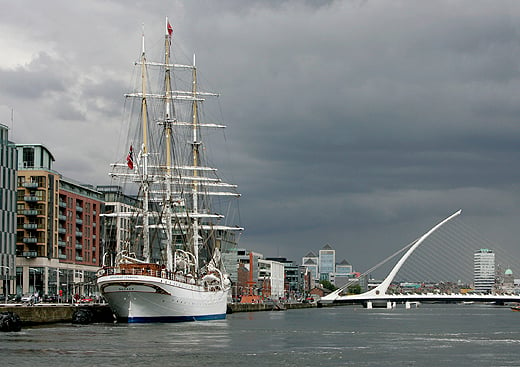


Her arrival marks nearly a year in advance to Dublin City welcoming the return of the Tall Ships Races, presented by Szczecin and organised by Sail Training International. The capital last hosted the event in 1998 and next year up to 100 tall ships are to sail into the capital which will be the final host port for four days between 23rd-26th August 2012.
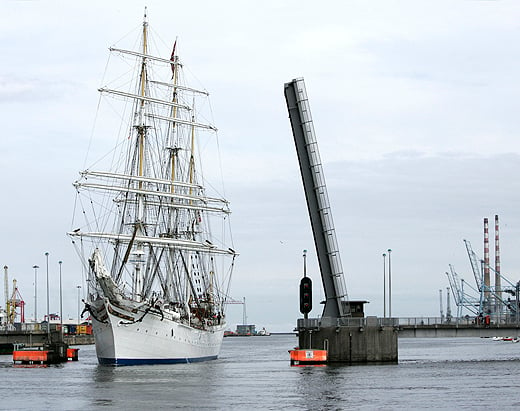
Tall Ship S/S Statsraad Lehmkuh in Dublin Bay yesterday. Images: Iain White
The celebration of sail is expected to draw entrants from as far away as Chile, Mexico, Argentina, USA and European and Baltic countries including Italy and Norway will chart their course to Dublin. It is hoped that the event will attract over a million visitors to the city, topping the 500,000 spectators who thronged the Waterford quays during this year's tall ship race gathering.
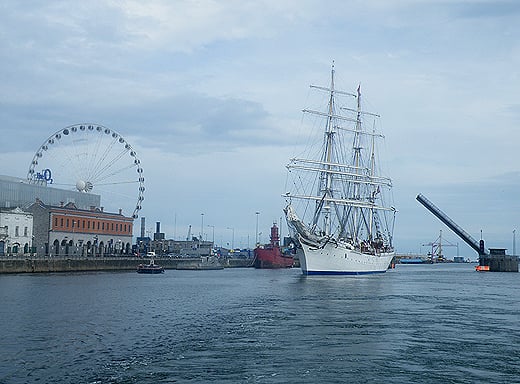
Photo: Jehan Ashmore
Small Is Beautiful as Cruiseships Call Closer to Capital
Clipper Odyssey is an unusual caller to the capital as she normally operates cruises in the Pacific Ocean from New Zealand to the Russian Far-East. As for Le Diamant she is a frequent caller not just to Dublin but throughout Irish ports during the season.
The Bahama-flagged 110-passenger Clipper Odyssey is scheduled to depart this evening around 21.45hrs. She is bound for Dunmore East with an lunchtime arrival off the Waterford fishing port. Le Diamant with a capacity for up to 226 passengers follows with a departure set for 23.00hrs and she is bound for Fishguard Harbour, the gateway to the scenic Pembrokeshire Coast National Park.
Currently only small cruiseships can dock within the 'Docklands' quarter quays due to the limitations imposed on dimensions, as vessels transit through the East-Link toll lift-bridge which was built in 1984. The majority of cruiseships, which are considerably larger and can exceed over 100,000 gross tonnes, berth 2kms downriver mostly in Alexandra Basin and adjoining Ocean Pier.
There are proposals to build a dedicated cruise-terminal close to the East-Link bridge on the far side at North Wall Quay Extension, which would allow such larger vessels to dock. This would facilitate easier access for cruise tourists to visit the attractions of the city-centre and indeed the nearby amenities of the O2 Arena, which would be within walking distance of the proposed cruise terminal.
- Dublin Port
- Dublin Docklands
- Sir John Rogerson's Quay
- Cruise Liners
- Cruiseships
- Sean O'Casey Bridge
- River Liffey
- Cruise Liner news
- Samuel Beckett Bridge
- Cruisecallers
- Le Diamant cruiseship
- Clipper Odyssey cruiseship
- Dublin GasWorks
- Dublin Gasometer
- Ringsend Gasworks
- Pembrokeshire Coast National Park
- O2 Arena
Dundalk Dredger Docked in Dublin Port Is Up for Sale
The Dublin Port Company has sought expressions from interested parties in undertaking the remaining activities of the port on an exclusive basis.
The Dundalk registered dredger arrived to the capital port on 14 July where she remains berthed at the Bulk Jetty in Alexandra Basin. Her previous owners, the Dundalk Port Company were unique in that they were the only port company to own and operate a dredger in the Republic. For many years the 757-tonnes dredger has carried out numerous contract assignments in ports throughout the island of Ireland including work on the Samuel Beckett swing-bridge and the most project was at Queens Quay, Belfast on the Lagan close to the city-centre.
Hebble Sand was launched by Richard (Shipbuilders) of Lowestoft for British Dredging and later used by Associated British Ports to serve a network of UK ports. Despite her age, the near fifty-year-old veteran vessel has been kept in excellent condition and this was evident during a rather unusual appearance for a ship of her type when attending the Dublin Docklands Maritime Festival in 2009.
She was made open for the public amongst the tall-ships that lined the Liffey Quays. Such an initiative was inspiring as it provided a rare opportunity for the public to access such a dredger which otherwise is not familiar compared to the popularity of visiting tall-ships and naval vessels.
The only other port to operate their own dredger is Londonderry Harbour Commissioners, whose Lough Foyle has worked on projects outside her homeport. This has included work at the new £40m Stena Line ferryport terminal on Loch Ryan close to Cairnryan and is due to open in November.
- Dublin Port
- Dublin Port Company
- Dundalk Port Company
- Stena Line
- Port of Dublin
- Ports and Shipping News
- Alexandra Basin
- Ferry news
- Dundalk Port
- Samuel Beckett Bridge
- Dredger Hebble Sand
- Dredger Lough Foyle
- Londonderry Harbour Commissioners
- Samuel Beckett SwingBridge
- Cairnryan ferryport
- Loch Ryan ferry terminal
- Associated British Ports
- ABP
- Richards Shipyard
- Queens Quay Belfast
- Dublin Docklands Maritime Festival 2009
Norway's Oldest A-Class Tallship Sets Sail for Dublin
STV Statsraad Lehmkuhl is scheduled to arrive in Dublin Bay on Thursday afternoon where she will enter through the port's East-Link lift toll-bridge and berth at Sir John Rogerson's Quay. She departed Bergen last Thursday and is currently heading for Stornoway on the Isle of Lewis.
She was originally christened Grossherzog Fridrich August when completed at the J.C. Tecklenborgwerft yard in Bremerhaven as a sail training ship for the German merchant navy.
In 1923 she changed hands and began a career with the Norwegian Shipowners Association on the initiative of the state Kritoffer Lehmkuhl. The vessel was renamed in his honour due to Lehmkuhl's dedication to the cause of cadetship programmes and his contribution in creating an independent Norwegian government in 1905.
She was transferred to the Bergen Schoolship Association in 1924. After many years serving the association the vessel was donated in 1978 to the Statsraad Lehmkuhl Foundation, an organisation also based in the country's second largest city.
Naval Salvage Tug Docks in Cork City
Built by Schichau Seebeck Werft, Bremerhaven, the 68m vessel has a limited armament capability and a crew of 45. Her main role is as a safety ship for use in submarine training and is equipped for fire-fighting, icebreaking and wreck location duties.
The veteran vessel had called to Dublin Port last weekend while her stay in the southern city will end with a departure scheduled for Monday morning.
Big Lips Kiss Dublin Bay
She was launched last year from the Meyer Werft shipyard. The 252 m vessel is operated by German operator Aida Cruises and the lips symbol is also the logo used by the company which operates a fleet of seven vessels.
Should you wish to take a closer look of Aidablu, she departs this evening at 21.00hrs and she will head out of Dublin Bay via the North Burford buoy off the Baily Lighthouse bound for Liverpool. The cruise started from Dover and after her visit to Merseyside tommorrow, she will then proceed to Greenock, followed by Invergorden before ending the cruise in Hamburg.
Tug-of-War to Visit Capital
She was built in 1967 by Schichau Seebeck Werft, Bremerhaven and the 68m / 23-ft long auxiliary has a limited armament capability and a crew of 45. Employed as safety ship for the submarine training group, she is also equipped for fire-fighting, icebreaking and wreck location duties. The Kiel registered veteran vessel is named after a German island.


























